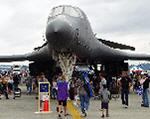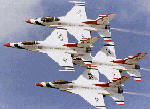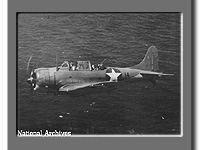
|
Description
| Manufacturer: | Douglas |
| |
| Base model: | SBD | ||
| Designation: | SBD | ||
| Version: | -4 | ||
| Nickname: | Dauntless | ||
| Equivalent to: | A-24 A24A-24 | ||
| Designation System: | U.S. Navy / Marines | ||
| Designation Period: | 1934-1946 | ||
| Basic role: | Scout Bomber | ||
| Crew: | Pilot and observer/rear gunner |
Specifications
| Length: | 32' 8" | 9.9 m | |
| Height: | 13' 7" | 4.1 m | |
| Wingspan: | 41' 6" | 12.6 m | |
| Wingarea: | 325.0 sq ft | 30.0 sq m | |
| Empty Weight: | 6,181 lb | 2,804 kg | |
| Gross Weight: | 10,179 lb | 4,625 kg | |
| Max Weight: | 10,200 lb | 4,627 kg | |
Propulsion
| No. of Engines: | 1 | ||
| Powerplant: | Wright R-1820-60 | ||
| Horsepower (each): | 1200 | ||
Performance
| Range: | 950 miles | 1,530 km | |
| Cruise Speed: | 173 mph | 278 km/h | 150 kt |
| Max Speed: | 250 mph | 402 km/h | 217 kt |
| Climb: | 1,700 ft/min | 518 m/min | |
| Ceiling: | 26,000 ft | 7,780 m | |
Known serial numbers
Examples of this type may be found at
| Museum | City | State |
| National Museum of Naval Aviation | NAS Pensacola | Florida |
| San Diego Aerospace Museum | San Diego | California |
SBD-4 on display
San Diego Aerospace Museum |
Recent comments by our visitors
| JohnD Buck Billings, MT | The comment on the movement of the canopy sections sent me to my copy of Wings of the Navy by Captain Eric Brown, RN which has a cutaway. The center section is fixed and the rear section slides forward under it while the front section slides back over it. A photo of the Dauntless in flight shows the front section closed and you can make out the curved portion of the open rear under the center section. For infrmation on many US and British naval airraft Capt. Brown is an expert, as his job was to run trials on available aircraft and advise Royal Navy pilots on how to best fly them. You can be sure that on my next trip to visit my son and family in Mobile I will reisit Pennsacola and pay more attention. 02/24/2009 @ 11:38 [ref: 23802] |
| JohnnyB. Monpelier, VT | This is a question rather than a comment. How does the rear canopy of an SBD work? I can never figure it out, and I don't know of any Dauntlesses near where I live. I've heard mention of a sliding canopy, but how can the whole thing slide forwards when the gunner is sitting right in the way of the sloping rear portion? I've heard that the SB2C had a collapsable portion of the decking behind the gunner, but this was nessecary on that plane because of its layout. All I can really imagine is that either the sloping rear of the canopy swings down inside the fuselage, which seems impossible if the .30cal is in the way, or the whole rear third of the canopy is removed before flight, and the gunner is always in an open cockpit until landing again. I have no idea, and it's been bugging me for ages. I hope I've made this clear enough, and if anybody could shed any light I would appreciate it. Email justforever96@yahoo.com 02/18/2009 @ 14:01 [ref: 23759] |
| Nathan W , GA | The SBD-4 at the National Museum of Naval Aviation (Serial Number 06833) is on display AS IT WAS FOUND on the bottom of Lake Michigan. A F4F-3 Wildcat Fighter (Serial Number 4039) is in the same condition. 05/02/2008 @ 12:44 [ref: 20781] |
| Curtiss Aldrich Pine Mtn. Lake Airport, CA | I have an original aluminum airframe data plate for a Douglas SBD-4 dated 11-11-42. The plane (not surprisingly) was made in El Segundo, California. Its sad to think that this is all that's left of this airplane.
Thank a Veteran Curtiss Aldrich 11/29/2007 @ 16:11 [ref: 18727] |
| Paul Weaver Mesa, AZ | During WW11 I was a plane captian on SBD's and heard of many tales from the crews as they came back.Regarding photo flights the rear seat had a Zero coming at them and he pointed his camera at him and he the Zero turned tail and left them alone.
At another time the rear gunner didn't stow his guns correctly and shot out all the bulkheads in the planes rear,this plane went to Davy Jones. I salvaged some bakolite from electric panel to make me knife which I still have..Fond Memories 03/19/2006 @ 14:20 [ref: 12863] |
| Barbara Spitler Valparaiso, IN | My father, Mann Spitler Jr., flew the Douglas Dauntless in the South Pacific in WWII, for the Marine Corps. He was extremely proud of his service and enjoyed sharing stories of his time in the Philippines, New Hebrides, etc.
Thanks for your website! 11/11/2005 @ 10:48 [ref: 11675] |
| Dale A. Wood , AL | There is also a Douglas SBD Dauntless on display in the National Air & Space Museum in Washington, DC. I don't know which "dash number" it is. It is there in a very good display of naval carrier aviation in WW-II. 01/15/2005 @ 19:16 [ref: 9149] |
| shorty , CT | these guys saved midway 12/09/2001 @ 17:28 [ref: 3795] |
| David Keller West Tisbury, MA | I attended the U.S. Naval Training School for Photography during Sept., Oct. and Nov. of 1944. This was located at Pensacola, Fla.. We used the SBD Dauntless as a training aircraft. The pilots were Navy and/or Marine fliers who were also students at the "photo school". We sailors were back-seat occupants and our task was to learn how to take photos in the air. We used a variety of Navy cameras including the K-20 which was fairly small and manueverable and had a big handle to hold onto. There was also a fitting aft of the photographer on which a 30 caliber machine gun could be mounted. For photo training the gun was removed, leaving a clear field of vision in the rear.
The big feature of the Dauntless was its ability to slow down through the use of its perforated diving brakes which were normally deployed (like flaps on today's aircraft) to control speed during a bombing dive. By deploying the brakes the pilot could slow the Dauntless down to approx. 90 knots The rear "greenhouse" canopy would be slid forward making the rear area an open cockpit and then at fairly low level the pilot would drop the port (left) wing and the photographer would lean out and (held from falling by a "gunners belt) he could take pictures at a variety of angles. The camera had to be held firmly in the "slipstream" because we were not allowed to have it fastened to us or to the aircraft since it could do damage if dropped. The Dauntless was the perfect aircraft for taking photos and it was truly a "fun" airplane to fly in. There is a beautiful restored one at the Navy Air Museum in Pensacola, Fla. 05/26/2001 @ 07:53 [ref: 2355] |








